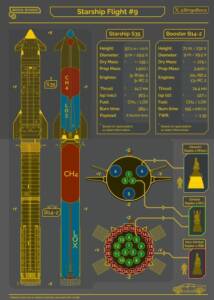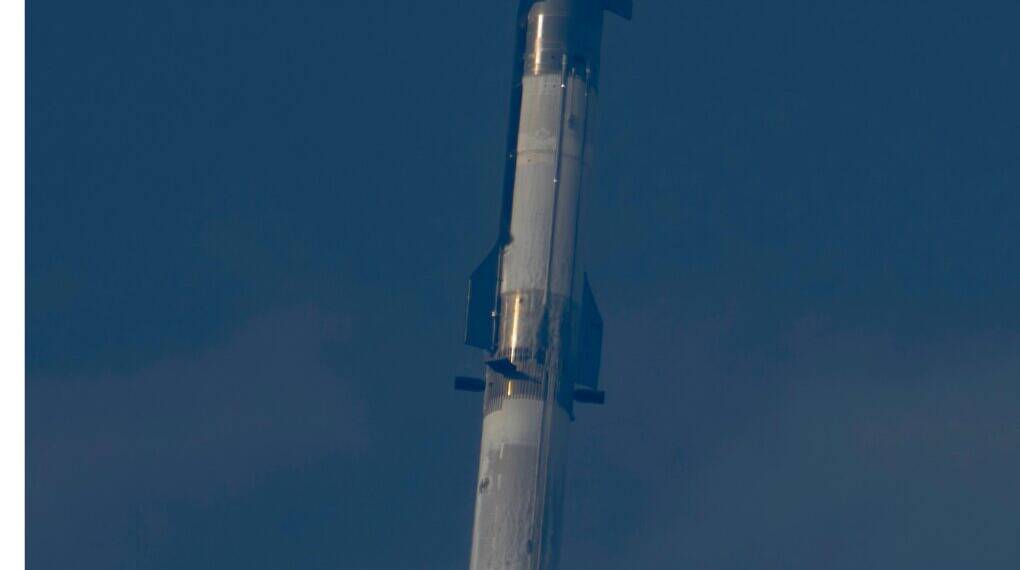SpaceX’s Starship has captured global attention as the world’s largest and most powerful rocket, a cornerstone of Elon Musk’s vision to make humanity a multi-planetary species. On May 27, 2025, Starship completed its ninth test flight, marking another step in its ambitious journey to revolutionize space travel. But what exactly is Starship, and how close is it to achieving its lofty goals? Let’s break down its design, objectives, recent milestones, and the challenges it faces.
What Is Starship?
Starship is a two-stage, fully reusable super heavy-lift launch vehicle developed by SpaceX, an aerospace company founded by Elon Musk in 2002. The system consists of two main components: the Super Heavy booster (first stage) and the Starship spacecraft (upper stage). When stacked, Starship stands at 121.3 meters (398 feet) tall, with a diameter of 9 meters (30 feet), making it taller than the Saturn V rocket that took humans to the Moon in 1969. It has a fueled mass of approximately 5,000 metric tons, powered by Raptor engines that burn liquid methane and liquid oxygen—a fuel choice that allows for potential production on Mars using local resources.
The Super Heavy booster, standing 71 meters tall, is equipped with 33 Raptor engines, generating unprecedented thrust. The Starship spacecraft, at 52.1 meters tall in its Block 2 version, has six Raptor engines (three standard and three vacuum-optimized for space). Both stages are constructed from stainless steel, chosen for its durability, cost-effectiveness, and ability to withstand the extreme temperatures of re-entry, thanks to a heat shield of 18,000 hexagonal tiles on the spacecraft’s windward side.
Starship’s design prioritizes full reusability; a feature SpaceX claims will drastically reduce launch costs. Unlike traditional rockets that are discarded after a single use, both stages are meant to return to Earth, with the Super Heavy booster being caught by the launch tower’s “chopstick” arms (nicknamed Mechazilla) and the spacecraft landing precisely for reuse. SpaceX aims for a payload capacity of 100–150 metric tons to low Earth orbit (LEO) in its reusable configuration, far surpassing the Falcon 9’s 22.8 metric tons.
Starship’s Goals: From Earth to Mars
Starship is central to SpaceX’s mission of enabling human settlement on Mars, a vision Musk has championed since the company’s inception. The rocket is designed to carry up to 100 people on long-duration interplanetary flights, with the ultimate goal of building self-sustaining cities on the Red Planet. Beyond Mars, Starship has a wide range of applications:
Moon Missions: Starship’s Human Landing System (HLS) variant is contracted by NASA to land astronauts on the Moon for the Artemis 3 mission, scheduled for 2027.
Earth Orbit Operations: It will deploy SpaceX’s next-generation Starlink satellites, capable of launching larger batches than the Falcon 9.
Point-to-Point Travel: Musk envisions using Starship for rapid Earth transport, potentially flying passengers anywhere on the planet in under an hour.
Cargo and Science: Starship’s large payload capacity could deliver massive scientific instruments, space telescopes, or lunar base materials, and even return significant samples from other planets.
A key feature enabling these missions is orbital propellant refilling. Starship spacecraft will rendezvous in orbit to transfer fuel, allowing for extended range to destinations like the Moon, Mars, or geostationary orbit. SpaceX plans to demonstrate this capability in 2025, a critical step for interplanetary travel.
Recent Developments: The Ninth Test Flight and Beyond
On May 27, 2025, Starship’s ninth test flight launched from SpaceX’s Starbase in Texas, marking a significant milestone: the first reuse of a flight-proven Super Heavy booster, which had previously flown in January 2025. The mission achieved stage separation and reached space, surpassing the points of failure in the prior two tests in January and March, which ended in explosions shortly after liftoff. However, the flight was not without issues. The Super Heavy booster exploded just before its planned splashdown in the Gulf of Mexico, and the Starship spacecraft spun out of control 30 minutes into the mission due to fuel leaks, breaking apart during an uncontrolled re-entry over the Indian Ocean.

Despite these setbacks, SpaceX views the test as progress. The spacecraft reached its scheduled engine cutoff, and no significant heat shield tiles were lost during ascent, addressing previous concerns. Elon Musk noted on X that the leaks caused a loss of main tank pressure during the coast and re-entry phases, but the flight provided valuable data for future improvements. He also hinted at an accelerated launch cadence, with the next three tests potentially occurring every three to four weeks.
Earlier successes, such as the fifth test flight on October 13, 2024, demonstrated the Super Heavy booster’s catch by Mechazilla, a historic feat in spaceflight. However, the 2025 tests highlight ongoing challenges, particularly with the spacecraft’s stability and reusability. SpaceX’s iterative approach—pushing hardware to failure to identify and fix issues—has drawn both praise for its boldness and criticism for its risks, especially after debris from earlier failed tests disrupted commercial flights over the Caribbean.
Challenges and Criticisms
Starship’s development is not without hurdles. The ninth test flight’s failure to achieve key objectives, like deploying mock Starlink satellites and executing a controlled re-entry, underscores persistent engineering challenges. Fuel leaks, engine reliability, and heat shield durability remain concerns, particularly for crewed missions where safety is paramount. The Federal Aviation Administration (FAA) has expanded hazard zones for Starship launches due to debris risks, reflecting the real-world consequences of SpaceX’s risk-tolerant testing strategy.
Cost is another point of contention. SpaceX claims Starship launches could eventually cost as little as $2 million, a fraction of traditional rocket launches, but some experts question whether the complexities of reusability, such as maintenance and refurbishment, might offset these savings. NASA’s Space Shuttle program, for instance, was criticized for being more expensive than expendable rockets despite its reusability.
Environmental concerns also loom large. Starship launches have faced scrutiny for their impact on the South Texas ecosystem, with environmental groups suing the FAA over inadequate assessments. The rocket’s methane-based engines, while enabling fuel production on Mars, produce carbon emissions, raising questions about SpaceX’s sustainability claims.
The Bigger Picture: A Multi-Planetary Future?
Starship’s potential to reshape space travel is undeniable. Its massive payload capacity and reusability could democratize access to space, enabling ambitious projects like lunar bases, Mars colonies, and rapid global transport. For science, the ability to return large samples from other planets could unlock new insights into the solar system’s history and the origins of life.
However, SpaceX’s narrative of inevitable success warrants scrutiny. The company’s aggressive timelines—such as Musk’s 2029 target for a Mars landing—have historically been overly optimistic. The technical challenges of crewed interplanetary travel, from radiation protection to life support, remain daunting. Moreover, Starship’s role in NASA’s Artemis program hinges on the readiness of other systems, like the Space Launch System, which has faced its delays.
Looking Ahead
Starship’s ninth test flight, while imperfect, demonstrates SpaceX’s commitment to iterative progress. The company’s ability to reuse a Super Heavy booster is a step toward rapid reusability, a cornerstone of its cost-reduction strategy. Upcoming tests will likely focus on resolving fuel leaks, improving re-entry stability, and achieving orbital propellant transfer—a critical milestone for deep-space missions.
Starship remains a work in progress, but its potential to redefine space exploration is clear. Whether it will truly make humanity multi-planetary or fall short like other ambitious space programs depends on SpaceX’s ability to overcome its technical, environmental, and financial challenges. For now, the world watches as Starship continues its journey—one test flight at a time.







